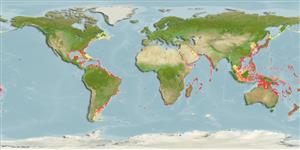Common names from other countries
Classification / Names / Names
Common names | Synonyms | Catalog of Fishes (gen., sp.) | ITIS | CoL | WoRMS
Environment: milieu / climate zone / depth range / distribution range
Ecology
Benthic; depth range 0 - 60 m (Ref. 7727). Tropical
Circumglobal tropical and temperate seas; Found in all warm water.
Length at first maturity / Size / Weight / Age
Maturity: Lm ? range ? - ? cm Max length : 30.0 cm TL male/unsexed; (Ref. 126605); max. published weight: 468.00 g (Ref. 126605); max. reported age: 1.00 years (Ref. 126605)
Maximum depth from Ref,. 109264. Sea hares have annual life cycles (Ref. 126605).
Life cycle and mating behavior
Maturity | Reproduction | Spawning | Eggs | Fecundity | Larvae
Members of the order Anaspidea are mostly simultaneous hermaphrodites (Ref. 833). Come inshore during March and April to lay its eggs. Copulation goes from several hours to several days. Once the eggs are laid, the adults return to shallow waters to die (Ref. 125338).
Debelius, H. 2001. (Ref. 844)
IUCN Red List Status (Ref. 130435: Version 2024-1)
CITES status (Ref. 108899)
Not Evaluated
Not Evaluated
Human uses
| FishSource |
Tools
More information
Age/SizeGrowthLength-weightLength-lengthMorphologyLarvaeAbundance
Internet sources
Estimates based on models
Preferred temperature
(Ref.
115969): 14.8 - 28.7, mean 26.5 (based on 1346 cells).
Vulnerability
Low vulnerability (16 of 100).
Price category
Unknown.
